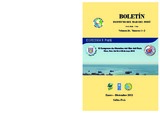Por favor, use este identificador para citar o enlazar este ítem:
https://hdl.handle.net/20.500.12958/2157Registro completo de metadatos
| Campo DC | Valor | Lengua/Idioma |
|---|---|---|
| dc.contributor.author | Solís Acosta, Juana | |
| dc.contributor.author | Velazco Castillo, Federico | |
| dc.contributor.author | Fernández Johnston, Ernesto | |
| dc.contributor.author | Carhuapoma, Wilson | |
| dc.date.accessioned | 2013-07-05T19:11:13Z | |
| dc.date.available | 2013-07-05T19:11:13Z | |
| dc.date.issued | 2011 | |
| dc.identifier.citation | Bol Inst Mar Perú 26(1-2), 2011: p. 25-31 | es_ES |
| dc.identifier.issn | 0458 - 7766 | |
| dc.identifier.uri | https://hdl.handle.net/20.500.12958/2157 | |
| dc.description | Boletín IMARPE vol. 26, nº 1-2, 2011; p. 25-31 | |
| dc.description.abstract | Se determinó la tendencia y variabilidad vertical de las características geoquímicas de los sedimentos y del agua intersticial en los primeros 10 cm superficiales de dos testigos de Callao, colectados en dos estaciones del perfil Callao, durante el Crucero Miniox BIC Olaya 0810: (1) E-2, a 8 mn de la costa y 98 m de profundidad, donde la materia orgánica presentó un amplio rango de variabilidad (4,75% a 56,34%) y una tendencia al incremento con la profundización del perfil vertical, al existir condiciones geoquímicas que favorecen una mayor preservación de la materia orgánica y una lenta remineralización; y (2) E-5, a 30 mn de la costa y 178 m de profundidad, donde la materia orgánica presentó una distribución más homogénea en el perfil vertical (30,72% a 36,17%). Las elevadas correlaciones (r > 0,7) de la materia orgánica total con el carbono orgánico total, así como con los fosfatos y los silicatos en sedimentos superficiales indican que la materia orgánica gobierna parcialmente las concentraciones de carbono y fósforo. La variabilidad en la conducta de distribución de las concentraciones de metales Redox sensitivos en los sedimentos recientes, está asociada a condiciones anóxicas y a la intensa actividad sulfato reductora característica en la zona de estudio. | es_ES |
| dc.description.abstract | ABSTRACT: We determined the trend and vertical variability of the geochemical characteristics of sediments and interstitial water in the first 10 cm of two sediment cores from Callao, collected in two stations of the Callao profile, during the Research Cruise BIC Olaya MINIOX 0810: (1) E -2, at 8 nm from the coast and 98 m in depth, where organic matter showed a wide range of variability (4.75% to 56.34%) and a tendency to increase along with the depth of the vertical profile, as there were geochemical conditions to favor the preservation of organic matter and slowing down the process of remineralization; and (2) E-5, 30 nm off the coast and 178 m in depth, where organic matter showed a more homogeneous distribution in the vertical profile (30.72% to 36.17%). The high correlations (r> 0.7) of total organic matter with total organic carbon, as well as with phosphates and silicates in surface sediments, indicate that organic matter partially dominates concentrations of carbon and phosphorus. The variability in the distribution pattern of Redox-sensitive metal concentrations in recent sediments is associated to anoxic conditions and the intense sulfate-reduction activity typical in the area of study | |
| dc.description.sponsorship | Proyecto GEF -PNUD - GEMCH | es_ES |
| dc.language.iso | spa | es_ES |
| dc.publisher | Instituto del Mar del Perú | es_ES |
| dc.relation.ispartofseries | Boletín;vol. 26(1-2), 2011 | |
| dc.rights | info:eu-repo/semantics/openAccess | - |
| dc.rights.uri | https://creativecommons.org/licenses/by/4.0/ | |
| dc.source | Instituto del Mar del Perú - IMARPE | |
| dc.source | Instituto del Mar del Perú - IMARPE | |
| dc.source.uri | Repositorio Digital IMARPE | |
| dc.subject | Biogeoquímica | es_ES |
| dc.subject | Sedimentos Marinos | es_ES |
| dc.subject | Materia Orgánica | es_ES |
| dc.subject | Metales | es_ES |
| dc.subject | Callao | es_ES |
| dc.title | Características geoquímicas de sedimentos del perfil Callao, Octubre 2008 | es_ES |
| dc.title.alternative | Profile sediment cores geochemical characteristics Callao, October 2008 | es_ES |
| dc.type | info:eu-repo/semantics/article | es_ES |
| Aparece en las colecciones: | Boletín 26(1-2), 2011 | |
Ficheros en este ítem:
| Fichero | Descripción | Tamaño | Formato | |
|---|---|---|---|---|
| Bol. vol. 26-3.pdf | 1,33 MB | Adobe PDF |  Visualizar/Abrir |
Este ítem está sujeto a una licencia Creative Commons Licencia Creative Commons

